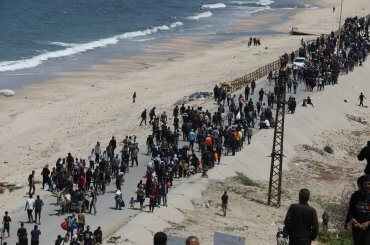The United States provided approximately $35 billion in economic aid to over 140 countries* in fiscal year 2014. In the map below the relative size of each country is proportionate to the aid received from the United States and the color of each country indicates GDP per capita.

Graphic: howmuch.net (Click to Enlarge)
How was this aid distributed?
Clearly, not all aid is distributed equally. The question is: Who received the largest slice of the pie from the U.S.? From the map above, the answer is clear: Israel.
Of the $35 billion of total economic aid distributed, almost a quarter of funds went to five countries. Below are the top 5 recipients of economic aid in 2014.
-
Israel: $3.1 billion
-
Egypt: $1.5 billion
-
Afghanistan: $1.1 billion
-
Jordan: $1.0 billion
-
Pakistan: $933 million
At first glance, one may wonder why Israel would receive roughly 9% of U.S. economic aid. It is important to note that foreign aid has a variety of uses depending on the current political, economic, and social climate. According to the U.S. State Government 2013-2015 Foreign Assistance report, all $3.1 billion of Israel’s funding was used for military financing. In Egypt, $1.3 billion of $1.5 billion received was used for military-related activities as well. On the other hand, the majority of funds received by Afghanistan, Jordan, and Pakistan were used for economic development purposes. Of the $35 billion referenced in the report, $8.4 billion (24%) was used towards global health programs, $5.9 billion (17%) was used for foreign military financing, $4.6 billion (13%) was used for economic support, and $2.5 billion (7%) was used for development assistance. Below is a breakout of aid received by geographic region in fiscal year 2014.
-
Africa: 20%
-
East Asia and Pacific: 2%
-
Europe and Eurasia: 2%
-
Near East: 20%
-
South and Central Asia: 7%
-
Western Hemisphere: 4%
-
General Aid: 45%
With 142 countries receiving aid out of the 188 countries listed with the International Monetary Fund (IMF) in 2014, approximately 76% of the world received some form of economic assistance from the U.S., the majority located within Africa and the Near East. Depending on future geopolitical events, this allocation is subject to change; however, according to the federal government’s 2015 estimates, the approximate $33 billion requests in aid follow a similar geographic allocation. Nonetheless, in the past three years, the economic support from the U.S. will have impacted a large majority of the world’s population, totaling $103 billion in economic support across various programs.



Afghanistan is a Central Asian country and Pakistan is a South Asian country. If both countries are included in the top 5 recipients of economic aid in 2014, how is it that you say South and Central Asia received only 7% of fiscal aid in 2014? You are clearly making the too-often-made mistake of counting non-Middle Eastern countries into the category of Middle Eastern simply because they are majority Muslim countries or because you do not know geography. Most Muslims are not Arab. The Middle East (Near East) is comprised of every Arab country as well as Turkey and Iran. That’s it, Pakistan and Afghanistan are not Middle Eastern (Near Eastern) countries. As an Arab-American Muslim I find this mistake incredibly annoying and frustrating. I thought the writers at Mondoweiss would know this basic fact before writing an article about the geographic distribution of foreign aid.
First thoughts:
1. Usa students could use a free $30k every year.
2. Releasing usa prisoners as penniless vagrants…and without even socks or underwear…seems a good destination for $30k a year…so they can believe in the usa…and succeed.
I retract my initial comment. I did the math. He did not include Afghanistan and Pakistan in the Near Eastern category. My apologies
Thanks for the very informative map of foreign aid. I expect that there are some refinements that people with the requisite knowledge might wish to add. For example, as well as GDP per capita of the recipient (nicely shown by the color), one might want to look at amount of aid per capita. Also, one might want to consider the “tax expenditure” or revenue forgone due to the tax-deductible nature of some donations to Israel. I suspect that there may well be other items such interest-free or subsidized loans, loan guarantees, loans forgiven, and payments of various kinds that don’t show up in the $3 billion, but I don’t know the specifics, which often seem obscure in the federal accounts, unless one is a budget wonk in CBO or OMB who knows where to look. Then too, it seems fair to say that much of the aid to countries that are Israel’s neighbors are really payments made on behalf of, or as a result of, our support for Israel.
The AID industry is a racket to funnel funds into arms and programs constructed by local elites with their associates on K-Street in DC to their own hands.
You and I can go to an impoverished country that is targeted for aid and make contact with some locals — those in power and influence — and then write a proposal to build and run, for example, a education center for girls. We fill in the blanks and get the dough.
Then with the help of our local contact we build a center — ‘with the help of his own contracting company, or course — and then buy tons of supplies from our buddies in New Jersey and ship it (or not) to country X where it sits there in boxes.
But the USAID (under the State Department) has on file that all this money was spent on aid. Reality is that it never went to aid and to doing anything but enriching a small circle.
This is how it works. I’ve been there, seen that in operation.
This is such a small tip of the iceberg
http://www.voanews.com/content/probe-of-suspended-usaid-contractor-deepens/2634844.html
Don’t ask me about the day of burning out dated army uniforms sent to the Balkans as AID where the manufacturer in North Carolina got a tax write off for the donation.